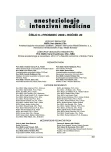Continuous infusion versus intermittent administration of vancomycin in critically ill patients with Gram-positive infections resistant to beta-lactam antibiotics
Authors:
Štěpán Martin 1; Chytra Ivan 1; Pelnář Petr 2; Bergerová Tamara 2; Kasal Eduard 1
Authors‘ workplace:
Anesteziologicko-resuscitační klinika, Fakultní nemocnice v Plzni, Univerzita Karlova v Praze, Lékařská fakulta v Plzni
1; Ústav mikrobiologie, Fakultní nemocnice v Plzni
2
Published in:
Anest. intenziv. Med., 20, 2009, č. 6, s. 309-316
Category:
Intensive Care Medicine - Original Paper
Overview
Objective:
The aim of study was to compare the clinical and microbiological efficacy of continuous infusion versus intermittent administration of vancomycin in critically ill patients with Gram-positive infections resistant to beta-lactam antibiotics. The second goal was to evaluate the safety of both the vancomycin administration modes in relation to renal function.
Design:
Prospective randomized controlled study.
Setting:
Interdisciplinary intensive care unit of a University teaching hospital.
Materials and methods:
Patients admitted to the interdisciplinary ICU suffering from Gram-positive infection indicated for vancomycin administration were randomized to receive either continuous infusion or intermittent administration of vancomycin according to defined protocols. In addition to the basic variables, parameters allowing evaluation of efficacy and safety of the continuous and intermittent administration of vancomycin were assessed. Paired and unpaired t-test, Mann-Whitney test, Wilcoxon test, chi-square test and Fisher’s exact test were used accordingly; p < 0.05 was considered statistically significant.
Results:
A total of 65 patients were enrolled and randomized to the continuous (n = 32) or intermittent (n = 33) groups. No significant differences between the groups were found in the clinical (69% vs. 64%; p = 0.58) and microbiological (59% vs. 76%; p = 0.23) efficacy, in the length of ICU stay, in ICU mortality, in the length of vancomycin therapy and in the total dose of vancomycin. No changes in serum creatinine concentration and glomerular filtration rate were detected during the period of vancomycin administration.
Conclusion:
Continuous infusion and intermittent administration of vancomycin in critically ill patients provided an equivalent clinical and microbiological outcome. Neither continuous nor intermittent administration of vancomycin was associated with deterioration of the renal function.
The intermittent mode of application required more frequent assessment of the serum vancomycin concentration.
Keywords:
vancomycin – continuous infusion – clinical efficacy – microbiological efficacy – nefrotoxicity
Sources
1. Löwdin, E., Odenholt, I., Cars, O. In vitro studies of pharmacodynamic properties of vancomycin against Staphylococcus aureus and Staphylococcus epidermidis. Antimicrob. Agents Chemother., 1998, 42, p. 2739–2744.
2. Knudsen, J. D., Fuursted, K., Raber, S. et al. Pharmacodynamics of glycopeptides in the mouse peritonitis model of Streptococcus pneumoniae or Staphylococcus aureus infection. Antimicrob. Agents Chemother., 2000, 44, p. 1247–1254.
3. Craig, W. A. Basic pharmacodynamics of antibacterials with clinical applications to the use of beta-lactams, glycopeptides, and linezolid. Infect. Dis. Clin. North Am., 2003, 17, p. 479–501.
4. Rybak, M. J. The pharmacokinetic and pharmacodynamic properties of vancomycin. Clin. Infect. Dis., 2006, 42, Suppl 1, p. 35–39.
5. Llopis-Salvia, P., Jimenez-Torres, N. V. Population pharmacokinetic parameters of vancomycin in critically ill patients. J. Clin. Pharm. Ther., 2006, 31, p. 447–454.
6. Roberts, J. A., Lipman, J., Blot, S., Rello, J. Better outcomes through continuous infusion of time-dependent antibiotics to critically ill patients? Curr. Opin. Crit. Care, 2008, 14, p. 390–396.
7. Wyncoll, D. L. A., Bowry, R., Giles L.J. Antibiotics by continuous infusion: Time for re-evaluation? In Vincent, J. L., ed. Yearbook of Intensive Care and Emergency Medicine 2002, Springer-Verlag: Berlin, Heidelberg, 2002, p. 399–403.
8. Micek, S. T., Ward, S., Fraser, V. J., Kollef, M. H. A randomized controlled trial of an antibiotic discontinuation policy for clinically suspected ventilator-associated pneumonia. Chest, 2004, 125, p. 1791–1799.
9. Levey, A. S., Bosch, J. P., Lewis, J. B. et al. A more accurate method to estimate glomerular filtration rate from serum creatinine: a new prediction equation. Modification of Diet in Renal Disease Study Group. Ann. Intern. Med., 1999, 130, p. 461–470.
10. Levey, A. S., Coresh, J., Ethan, B. et al. National Kidney Foundation Practice Guidelines for Chronic Kidney Disease: Evaluation, Classification, and Stratification. Ann. Intern. Med., 2003, 139, p. 137–147.
11. Di Filippo, A., De Gaudio, A. R., Novelli A. et al. Continuous infusion of vancomycin in methicillin-resistant staphylococcus infection. Chemotherapy, 1998, 44, p. 63–68.
12. Wysocki, M., Delatour, F., Faurisson, F. et al. Continuous versus intermittent infusion of vancomycin in severe staphylococcal infections: prospective multicenter randomized study. Antimicrob. Agents Chemother., 2001, 45, p. 2460–2467.
13. Rello, J. et al. Pneumonia caused by oxacillin-resistant Staphylococcus aureus treated with glycopeptides. Crit. Care Med., 2005, 33, p. 1983–1987.
14. Vuagnat, A., Stern, R., Lotthe, A. et al. High dose vancomycin for osteomyelitis: continuous vs. intermittent infusion. J. Clin. Pharm. Ther., 2004; 29, p. 351–357.
15. Rybak, M. J., Albrecht, L. M., Boike, S. C., Chandrasekar, P. H. Nephrotoxicity of vancomycin, alone and with an aminoglycoside. J. Antimicrob. Chemother., 1990, 25, p. 679–687.
Labels
Anaesthesiology, Resuscitation and Inten Intensive Care MedicineArticle was published in
Anaesthesiology and Intensive Care Medicine

2009 Issue 6
Most read in this issue
- Bleeding complications and overdosing of anticoagulant therapy
- Ethical problems experienced during emergency medical care provision
- Continuous infusion versus intermittent administration of vancomycin in critically ill patients with Gram-positive infections resistant to beta-lactam antibiotics
- Prim. MUDr. Jiří Dostál
